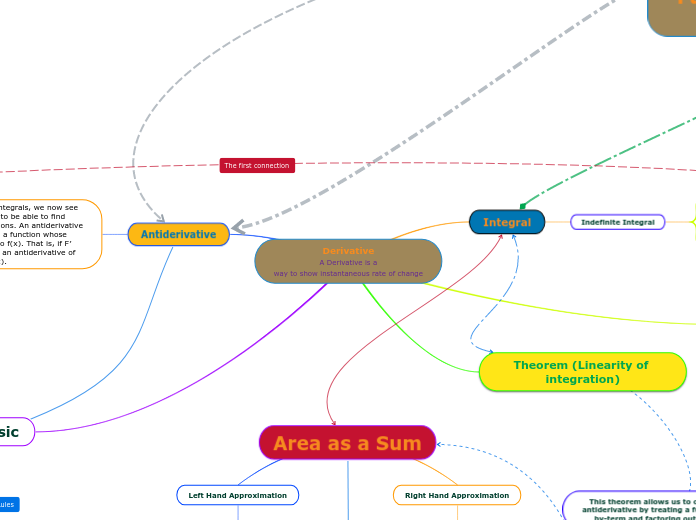Derivative
A Derivative is a
way to show instantaneous rate of change
Integral
Indefinite Integral
An indefinite integral is an integral written without terminals; it simply asks us to find a general antiderivative of the integrand. It is not one function but a family of functions
∫ x^2 dx= x^3/3 + c
1: ∫(f(x)±g(x))dx = ∫f(x)dx±∫g(x)dx
2: ∫ kf(x)dx = k∫f(x)dx
Theorem (Linearity of integration)
Antiderivative
In order to calculate integrals, we now see that it's important to be able to find antiderivatives of functions. An antiderivative of a function f(x) is a function whose derivative is equal to f(x). That is, if F′(x)=f(x), then F(x) is an antiderivative of f(x).
A given function can have many antiderivatives. For instance, the following functions are all antiderivatives of x2 : x^3/3, x^3/3 +1, x^3/3 + 42, and more.
Because any two antiderivatives differ by a constant
c, we can write a general antiderivative. For x^2, it would be x^3/3 + C.
Basic
function = general antiderivative
x^n = (1/n+1)x^(n+1)+c
(ax+b)^n = 1/a(n+1)(ax+b)^(n+1)+c
1: If f and g are continuous functions
2: If f is a continuous function and k is a real constant
This theorem allows us to compute an antiderivative by treating a function term-by-term and factoring out constants
sin(x)dx = - cos(x) + c
cos(x)dx = sin(x) + c
sec2(x)dx = tan(x) + c
Examples
Integral 4dx
=
4x + C
Integral (3x + 4)dx
=
3(x^2/2) + 4x + C
integral sin(2x)dx
=
-cos(2x)1/2 + c
Area as a Sum
Left Hand Approximation

We would divide a curve(for example y=x^2) into 3 even sections along the x-axis. This would be 0-1/3, 1/3-2/3, and 2/3-1. We then add the areas under the curve.
Right Hand Approximation

We would do the same staring process for this method. We then use the value of the function at the right endpoint of each subdivision as the height.
Mid-Point approximation

For the third method, we would use the value of the function at the midpoint of each of the subdivisions as the height.
The problem with these three is that they are not very exact. To fix this, we want to increase our sub-divisions of the graph from three to a much larger number.

We will be generalizing the previous left hand method. To do this, we will be finding the area under the graph f between a and b, with n subdivisions.
Because we are using the left point as the height, f1 is 0, and Ln is as follows.
Ln = f (x0)Δx + f (x1)Δx + ...f (xn-1)Δx

We will collapse this into a summation,
Ln = this summation^f(xk)Δx
(Keep in mind RH summation would look similar, but k = 1 instead)
Now we want to combine this condensed summation with the increase in subdivisions. We are going to need infinite subdivisions, and the best way to achieve that is through limits.

